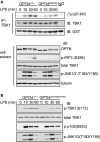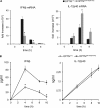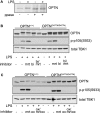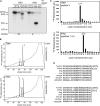Polyubiquitin binding to optineurin is required for optimal activation of TANK-binding kinase 1 and production of interferon β
- PMID: 21862579
- PMCID: PMC3195586
- DOI: 10.1074/jbc.M111.267567
Polyubiquitin binding to optineurin is required for optimal activation of TANK-binding kinase 1 and production of interferon β
Abstract
TANK-binding kinase (TBK1) is essential for transcription of the interferon (IFN) β gene in response to lipopolysaccharide (LPS) and double-stranded RNA, but the molecular mechanisms that underlie the activation of TBK1 are incompletely understood. Previously, we identified the NF-κB essential modulator (NEMO)-related polyubiquitin-binding protein, optineurin (OPTN), as a novel binding partner of TBK1. To determine whether the ubiquitin-binding function of OPTN is involved in regulating TBK1 and IFNβ production, we generated a mouse in which wild-type optineurin was replaced by the polyubiquitin binding-defective mutant, OPTN(D477N/D477N). In this study, we found that LPS or poly(I:C)-induced TBK1 activity was significantly reduced in bone marrow-derived macrophage (BMDM) from OPTN(D477N/D477N) mice. Consistent with this, the phosphorylation of IFN regulatory factor 3 (IRF3) and the production of IFNβ mRNA and secretion were reduced. Stimulation of BMDMs with LPS triggered the phosphorylation of OPTN, which was reversed by phosphatase treatment and prevented by pharmacological inhibition of both the canonical IκB kinases (IKKα/β) and the IKK-related kinases (TBK1/IKKε). In contrast, LPS-stimulated phosphorylation of OPTN(D477N) was markedly reduced in BMDMs from OPTN(D477N/D477N) mice, and inhibition of the canonical IKKs alone prevented phosphorylation, providing further evidence that ubiquitin binding to OPTN contributes to LPS-induced TBK1 activation. TBK1 and IKKβ phosphorylated OPTN preferentially at Ser-177 and Ser-513, respectively, in vitro. In conclusion, our results suggest that OPTN binds to polyubiquitylated species formed in response to LPS and poly(I:C), enhancing the activation of TBK1 that is required for optimal phosphorylation of IRF3 and production of IFNβ.
Figures








Similar articles
-
Identification of TBK1 complexes required for the phosphorylation of IRF3 and the production of interferon β.Biochem J. 2017 Mar 15;474(7):1163-1174. doi: 10.1042/BCJ20160992. Biochem J. 2017. PMID: 28159912 Free PMC article.
-
Optineurin insufficiency impairs IRF3 but not NF-κB activation in immune cells.J Immunol. 2013 Dec 15;191(12):6231-40. doi: 10.4049/jimmunol.1301696. Epub 2013 Nov 15. J Immunol. 2013. PMID: 24244017 Free PMC article.
-
Use of the pharmacological inhibitor BX795 to study the regulation and physiological roles of TBK1 and IkappaB kinase epsilon: a distinct upstream kinase mediates Ser-172 phosphorylation and activation.J Biol Chem. 2009 May 22;284(21):14136-46. doi: 10.1074/jbc.M109.000414. Epub 2009 Mar 22. J Biol Chem. 2009. PMID: 19307177 Free PMC article.
-
Regulation and function of IKK and IKK-related kinases.Sci STKE. 2006 Oct 17;2006(357):re13. doi: 10.1126/stke.3572006re13. Sci STKE. 2006. PMID: 17047224 Review.
-
The Role of Optineurin in Antiviral Type I Interferon Production.Front Immunol. 2018 Apr 26;9:853. doi: 10.3389/fimmu.2018.00853. eCollection 2018. Front Immunol. 2018. PMID: 29755463 Free PMC article. Review.
Cited by
-
From animal models to human disease: a genetic approach for personalized medicine in ALS.Acta Neuropathol Commun. 2016 Jul 11;4(1):70. doi: 10.1186/s40478-016-0340-5. Acta Neuropathol Commun. 2016. PMID: 27400686 Free PMC article. Review.
-
The World of Stable Ribonucleoproteins and Its Mapping With Grad-Seq and Related Approaches.Front Mol Biosci. 2021 Apr 7;8:661448. doi: 10.3389/fmolb.2021.661448. eCollection 2021. Front Mol Biosci. 2021. PMID: 33898526 Free PMC article. Review.
-
SAMHD1 deficient human monocytes autonomously trigger type I interferon.Mol Immunol. 2018 Sep;101:450-460. doi: 10.1016/j.molimm.2018.08.005. Epub 2018 Aug 9. Mol Immunol. 2018. PMID: 30099227 Free PMC article.
-
Single-cell RNA sequencing uncovers the nuclear decoy lincRNA PIRAT as a regulator of systemic monocyte immunity during COVID-19.Proc Natl Acad Sci U S A. 2022 Sep 6;119(36):e2120680119. doi: 10.1073/pnas.2120680119. Epub 2022 Aug 23. Proc Natl Acad Sci U S A. 2022. PMID: 35998224 Free PMC article.
-
Nearly 30 Years of Animal Models to Study Amyotrophic Lateral Sclerosis: A Historical Overview and Future Perspectives.Int J Mol Sci. 2021 Nov 12;22(22):12236. doi: 10.3390/ijms222212236. Int J Mol Sci. 2021. PMID: 34830115 Free PMC article. Review.
References
-
- Wang C., Deng L., Hong M., Akkaraju G. R., Inoue J., Chen Z. J. (2001) Nature 412, 346–351 - PubMed
-
- Haas T. L., Emmerich C. H., Gerlach B., Schmukle A. C., Cordier S. M., Rieser E., Feltham R., Vince J., Warnken U., Wenger T., Koschny R., Komander D., Silke J., Walczak H. (2009) Mol. Cell 36, 831–844 - PubMed
-
- Tokunaga F., Sakata S., Saeki Y., Satomi Y., Kirisako T., Kamei K., Nakagawa T., Kato M., Murata S., Yamaoka S., Yamamoto M., Akira S., Takao T., Tanaka K., Iwai K. (2009) Nat. Cell Biol. 11, 123–132 - PubMed
Publication types
MeSH terms
Substances
Grants and funding
LinkOut - more resources
Full Text Sources
Other Literature Sources
Molecular Biology Databases
Miscellaneous

